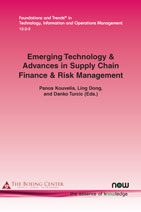Material and Cash Flow in Two-Tier Supply Chain with Trade Credits and Defaults
By Mabel C. Chou, National University of Singapore, Singapore, bizchoum@nus.edu.sg | Chung-Piaw Teo, National University of Singapore, Singapore, bizteocp@nus.edu.sg | Yuan-Guang Zhong, South China University of Technology, China, bmygzhong@scut.edu.cn
Abstract
We develop a supply chain finance and inventory model to understand how trade credit terms affect a firm’s financing costs and inventory decision along the supply chain. In particular, we study the following question: how should a warehouse (or distributor) receiving trade credits from an external supplier share and extend the trade credit terms to her customers (i.e. retailers)? How does this financial flow affect the replenishment decisions (i.e. material flow) in the system? We use the classical echelon inventory approach to synthesize the effects of trade credits in a one-warehouse-multi-retailer system. Payment default from retailers are considered and trade credit limit is used as a risk management tool. Interestingly, we show that longer credit terms from the external supplier may not necessarily translates into longer credit terms for the retailers in some supply chain environments.
Emerging Technology & Advances in Supply Chain Finance & Risk Management
Emerging Technology & Advances in Supply Chain Finance & Risk Management reflects the state-of-the-art in research thought leadership in supply chain finance and risk management, and it contains great expository pieces on how advanced technologies are shaping supply chains and risk management within them. You will also find ideas on how supply chain finance and risk management can be best taught in our classrooms.
The volume is divided into three parts, each part reflecting a major active research area of the field including: Part 1: Supply Chain Finance; Part 2: Financial Hedging and Commodity Risks; Part 3: Operational Strategies and Risk Management.
Part 1 deals with the broad area of supply chain finance and programs that will better allow for working capital management within supply chains. Part 2 introduces concepts of hedging financial and operational risks due to uncertain commodity prices, fluctuating exchange rates, and volatile interest rates. Emphasis is placed on understanding how financial hedges can be used for hedging relevant supply chain risks in a way that reflects modern view of financial risk management. Part 3 examines topics and solution approaches reflecting the more traditional treatments in the contemporary literature of operational and supply chain risks. This volume provides rich implications for future research directions in efforts to master the new complexities and uncertainties of the global business environment and better understand the impact of advanced technologies in global supply chains.

Companion
Foundations and Trends® in Technology, Information and Operations Management, Volume 12, Issue 2-3 Special Issue: Emerging Technology & Advances in Supply Chain Finance & Risk Management
See the other articles that are also part of this special issue.